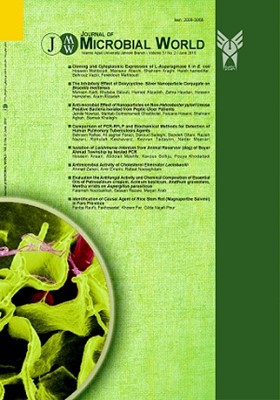Isolation of Leishmania infantum from animal reservoir (dog) of Boyer Ahmad township by Nested PCR
Subject Areas : Molecular Microbiology
Hossein Ansari
1
,
Abdolali Moshfe
2
*
,
Kavous Solhju
3
,
Pouya Khodadadi
4
![]()
1 - Department of Microbiology, Jahrom Branch, Islamic Azad University, Jahrom, Iran
2 - Cellular & Molecular Research Center, Yasuj University of Medical Sciences, Yasuj, Iran
3 - Faculty of Medicine, Jahrom University of Medical Sciences, Jahrom, Iran
4 - Department of Microbiology, Jahrom Branch, Islamic Azad University, Jahrom, Iran
Keywords: Dog, Nested PCR, visceral leishmaniosis,
Abstract :
Background and Objective: The visceral leishmaniosis is a common disease between human and animal caused by Leishmania infantum. The main resource of this disease is canidae family. This study was conducted to determine the genus and species of the parasites that cause visceral leishmaniosis in Boyer Ahmad City. Materials and Methods: In this study, the smears were prepared from spleen and liver extracts of 15 dogs in Boyerahmad city that were suspected to visceral leishmaniosis according to clinical signs (2010). Also some of the samples were evaluated by Nested-PCR to determine the geneus and species of the parasite. Results: According to the smear observation and Nested-PCR results, 14 cases (93.3%) and one case (6.7%) of the samples have been detected as Leishmania infantum and Leishmania major, respectively. Conclusion: The molecular results showed that the main etiological agent of visceral leishmaniosis in the animal reservoir (dogs) of BoyerAhmad Township is Leishmania infantum. However, Leishmania major also was detected as one of the causes of visceral leishmaniosisin in the region.
1. Alvar J, Yactayo S, Bern C. Leishmaniasis and poverty. Trends parasitol. 2006; 22(12): 552-557.
2. Desjeux P. increasing risk factors for leishmaniasis Worldwide. Trans R Soc Trop Med Hyg. 2001; 95(3): 239–243.
3. World Health Organization (WHO). http://www.who.int/ctd/chagas/disease.htm. 2007.
4. Alvar J, Molina R, San Andres M, Tesouro M, Nieto J, Vitutia M, González F, San Andrés MD, Boggio J, Rodriguez F. Canine leishmaniasis: clinical, parasitological and entological follow-up after chemotherapy. Ann Trop Med Parasitol. 1994; 88(4): 371-378.
5. Mohebali M, Edrissian GH, Shirzadi MR, Akhoundi B, Hajjaran H, Zarei Z, Molaei S, Sharifi I, Mamishi S, Mahmoudvand H, Torabi V, Moshfe A, Malmasi A, Motazedian MH, Fakhar M. An observational study on the current distribution of visceral leishmaniasis in different geographical zones of Iran and implication to health policy. Travel Med Infect Dis. 2011; 9(2): 67-74.
6. Sarkari B, Pedram N, Mohebali M, Moshfe AA, Zargar MA, Akhoundi B, Shirzadi MR. Seroepidemiological study of visceral leishmaniasis in Booyerahmad district, south-west Islamic Republic of Iran. East Mediterr Health J. 2010; 16(11): 1133-1136.
7. Motazedian H, Karamian M, Noyes HA, Ardehali S. DNA extraction and amplification of leishmania from archived, Giemsa-stained slides for the diagnosis 0f cutaneous leishmaniasis by PCR. Ann Trop Med Parasitol. 2002; 96(1): 31-34.
8. Moemenbellah-Fard MD, Kalantari M, Rassi Y, Javadian E. The PCR-based detection of Leishmania major infections in Meriones libycus (Rodentia:Muridae)from southern Iran. Ann Trop Med Parasitol. 2003; 97(8): 811-816.
9. Mohebali M, Hamzavi Y, Edrissian GhH, Frouzani AR. Seroepidemiological studies of visceral leishmaniasis in Bushehr province South I.R. of Iran. East Mediterr Health J. 2001; 7(6): 912-917.
10. Mohebali M, Motazedian MH, Parsa F, Hajjaran H. Identification of Leishmania species from different parts of Iran using a randomamplified polymorphic DNA in human, animal reservoirs and vectors. Med J Islamic Rep Iran. 2002; 15(4): 243-246.
11. Moshfe A, Zarei Z, Akhoundi B, Edrissian Gh, Kazemi B, Jamshidi Sh,Mahmoudi M, Bandehpour M.,Mohebali M. Comparsion between serology and PCR methods for the diagnosis of viseral Leishmaniasis. Armaghane-danesh. 2009; 14(2): 31-43. [In persian].
12. Moshfe A, Mohebali M, Edrissian GH, Zarei Z, Akhoundi B, Kazemi B, Jamshidi S, Mahmoodi M. Canine visceral leishmaniasis: Asymptomatic infected dogs as a source of L. infantum infection. Acta Trop. 2009; 112(2): 101-105.
13. Mohebali M, Poormohammadi B, Kanani A, Edrissian GhH, Anvari S. Rodents-Gerbillidae-Cricetidae-another animal host of visceral leishmaniasis in Meshkin-Shahr district, I.R. of Iran. East Mediterr Health J. 1998; 4(2): 376-78.
14. Mohebali M, Hamzavi Y, Fallah E, Zarei Z. Study of canine visceral leishmaniasis in some parts of Iran and its health importance. Tehran Univ Vet Fac J. 2001; 56: 55-59.
15. Mohebali M, Hajjaran H, Hamzavi Y, Mobedi I, Arshi S, Zarei Z, Akhoundi B, Naeini KM, Avizeh R, Fakhar M. Epidemiological aspects of canine visceral leishmaniosis in the Islamic Republic of Iran. Vet Parasitol. 2005; 129(3-4): 243-51.
16. Hatam GR, Adnani SJ, Asgari Q, Fallah E, Motazedian MH, Sadjjadi SM, Sarkari B. First report of natural infection in cats with Leishmania infantum in Iran. Vector Borne Zoonotic Dis. 2010; 10(3): 313-316.

